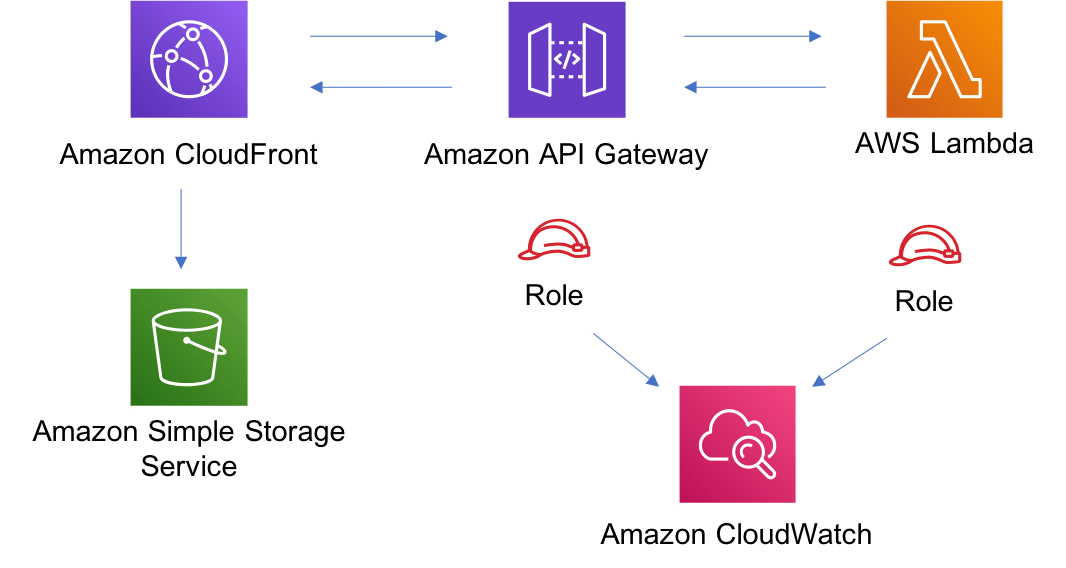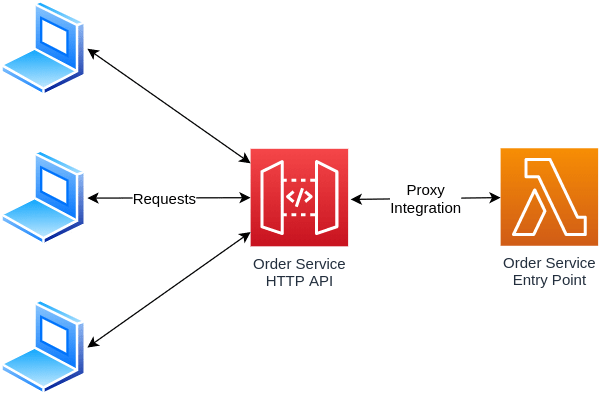
- Introduction to Amazon API Gateway
- Key Features of API Gateway
- How API Gateway Works
- Amazon API Gateway vs AWS Lambda
- Security and Authentication in API Gateway
- Pricing Model and Cost Optimization
- Use Cases for Amazon API Gateway
- Monitoring and Logging in API Gateway
- Conclusion
Introduction to Amazon API Gateway
Amazon API Gateway is a fully managed service provided by AWS that allows developers to create, publish, maintain, monitor, and secure APIs at any scale. APIs enable communication between client applications and backend services in a monolithic or microservices-based architecture. API Gateway acts as a “front door” for applications, providing a simple, cost-effective, and scalable solution for managing HTTP-based APIs. API Gateway integrates seamlessly with other AWS services like AWS Lambda, EC2, and DynamoDB, allowing developers to easily route API requests to backend services and handle tasks like authorization, access control, and monitoring. Abstracting the complexity of managing API infrastructure enables businesses to focus on developing their applications instead of worrying about scaling and maintaining the API infrastructure.
Key Features of API Gateway
Amazon API Gateway offers several features that make it an attractive solution for building and managing APIs:
- Fully Managed: API Gateway is fully managed, meaning AWS takes care of the underlying infrastructure, scaling, and security of the API.
- Scalable: It automatically scales to accommodate API traffic, whether a small application or a massive enterprise system with millions of requests.
- Customizable Request and Response Handling: It allows you to define how requests and responses are processed using mapping templates, enabling custom transformations of request/response payloads.
- Integrated Monitoring: API Gateway integrates with Amazon CloudWatch, allowing you to monitor API requests, log traffic patterns, and identify potential issues.
- Rate Limiting and Throttling: You can define usage plans and rate limits to control API consumption, ensuring that your backend systems aren’t overwhelmed.
- Caching: API Gateway offers caching capabilities to reduce the load on backend services by caching responses to frequently accessed data.
- Versioning and Staging: It supports versioning of your API, allowing you to manage different versions of your API across various environments (e.g., development, staging, and production).
How API Gateway Works
API Gateway is designed to simplify exposing backend services to the public or private internet. Here’s a simplified flow of how it works: To create an API with Amazon API Gateway, you start by defining resources (URLs) and methods (e.g., GET, POST, PUT, DELETE) that serve as different endpoints for user interactions. Each method can be integrated with various backend systems such as AWS Lambda, EC2 instances, or any HTTP-based service, allowing API Gateway to handle request routing efficiently. During request processing, API Gateway performs necessary transformations or validations before invoking the backend service while enforcing security mechanisms like authentication and authorization (e.g., OAuth, API keys). Once the backend responds, API Gateway can transform the response, converting it into formats like JSON or XML before returning it to the client. To optimize performance, API Gateway offers caching to serve frequently requested responses quickly and implements throttling to prevent excessive requests from overwhelming the API. Additionally, it integrates with Amazon CloudWatch for logging and monitoring, providing valuable insights into API performance, usage trends, and potential errors.

Amazon API Gateway vs AWS Lambda
Amazon API Gateway and AWS Lambda often work together but serve different purposes:
- API Gateway: It provides the API endpoint for receiving HTTP requests, manages the routing, and handles tasks like security, throttling, and caching. It acts as the “front door” for APIs and client interfaces (e.g., browsers and mobile apps).
- AWS Lambda: Lambda is a serverless computing service that runs your backend code in response to events, such as API requests. It processes the business logic for each API call and returns a response.
While API Gateway handles HTTP communication and API lifecycle management, AWS Lambda executes the code behind the scenes when a request is received. Together, they create scalable, serverless applications.
Security and Authentication in API Gateway
Azure provides tools to help data scientists, data engineers, and AI engineers create sophisticated machine-learning models. These tools include:
- API Keys: You can generate API keys for clients that need to authenticate before requesting your API. This method is suitable for essential usage control but does not provide robust security for sensitive data.
- AWS IAM Roles and Policies: API Gateway integrates with AWS Identity and Access Management (IAM) to control access based on roles and policies. IAM can restrict who can invoke specific API methods or access backend services.
- Cognito User Pools: You can use Amazon Cognito for user authentication, which integrates with API Gateway to provide secure access using various authentication methods (e.g., user pools, federated identities).
- Lambda Authorizers: Lambda authorizers allow you to implement custom authentication and authorization logic using AWS Lambda functions, providing more granular access control.
- OAuth 2.0: API Gateway supports OAuth 2.0 to integrate with third-party identity providers like Google, Facebook, and others, enabling secure authentication for users.
Pricing Model and Cost Optimization
API Gateway follows a pay-as-you-go pricing model, ensuring you only pay for the resources you use. The primary cost components include request charges, where you are billed based on the number of API requests made, and data transfer costs, which depend on the volume of data sent from API Gateway to clients or other services. If caching is enabled, charges are incurred based on the cache capacity used, and additional costs apply for using custom domain names. To optimize expenses, enabling caching helps reduce the load on backend services by storing responses for frequently accessed data. Implementing usage plans and throttling prevents excessive API requests, avoiding unnecessary costs. Additionally, monitoring API usage through AWS Cost Explorer and Cloud Watch metrics provides insights into request patterns, allowing for better cost management and optimization.

Use Cases for Amazon API Gateway
- Serverless Applications: In serverless architectures, the API Gateway is the entry point for invoking AWS Lambda functions for business logic processing.
- Microservices Architecture: API Gateway enables communication between microservices by providing a single entry point for all API calls.
- Mobile Applications: It acts as the backend API for mobile apps, handling incoming HTTP requests and forwarding them to backend services like databases or Lambda functions.
- Third-Party Integrations: If you need to expose APIs for third-party developers to integrate with your platform, API Gateway can securely expose APIs and manage access.
- Public APIs: For public-facing APIs that require high availability, scalability, and security, API Gateway provides an ideal solution for exposing RESTful APIs.
Monitoring and Logging in API Gateway
Monitoring and logging are crucial for understanding the health and usage of your API. API Gateway integrates with Amazon CloudWatch for real-time monitoring and diagnostics:
- Cloud Watch Logs: API Gateway can log requests and responses, providing insight into usage patterns, error rates, and performance.
- Cloud Watch Metrics: Metrics like request count, latency, and error rate are available in Cloud Watch, which can help identify bottlenecks or issues with your API.
- Cloud Watch Alarms: Set up alarms to be notified if any metric (e.g., latency, error rates) crosses a threshold, allowing you to react proactively to potential problems.
Conclusion
Amazon API Gateway is a highly scalable and fully managed service that simplifies the process of creating, deploying, and managing APIs in AWS. It acts as an entry point for applications, enabling secure and controlled access to backend services, including AWS Lambda, EC2, and DynamoDB. With built-in security features such as authentication, authorization, and request throttling, API Gateway ensures robust protection against unauthorized access and traffic spikes. It supports both RESTful APIs and WebSocket APIs, making it versatile for various application needs. API Gateway seamlessly integrates with AWS services, allowing developers to build serverless applications and microservices architectures with minimal operational overhead. Its caching capabilities help reduce latency and improve performance by storing responses for frequently requested data. The service provides detailed monitoring and logging through AWS CloudWatch, enabling real-time insights into API usage and performance. Developers can create custom domain names, apply rate limiting, and implement request validation to enhance API reliability. With automatic scaling, API Gateway efficiently handles fluctuating workloads without requiring manual intervention. Whether you’re building APIs for web applications, mobile apps, or IoT devices, API Gateway ensures high availability, cost efficiency, and seamless integration within the AWS ecosystem.





